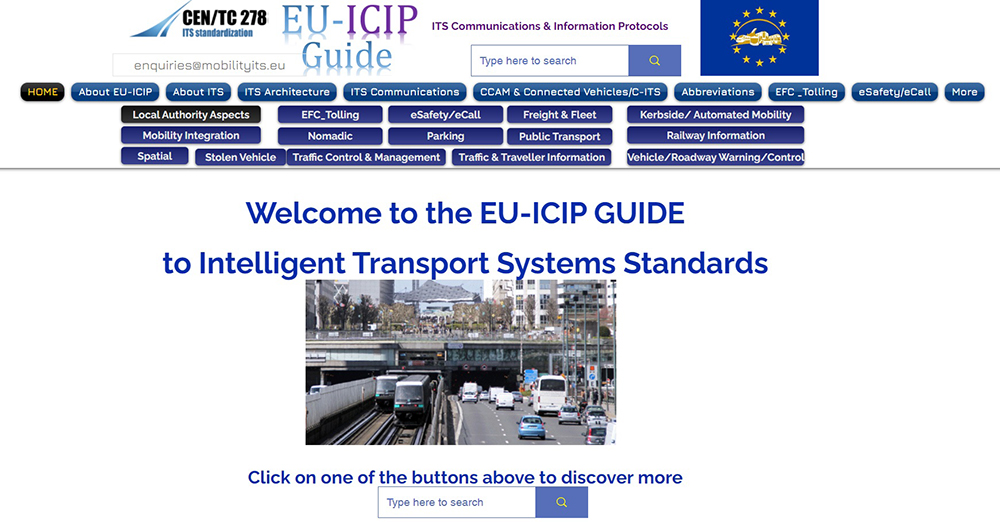
The ITS sector is intrinsically interactive and interdependent. It is about systems and equipment working together to provide services. The ability of one system, or element of a system, to understand data from another, and frequently to act and interact with others, is inherent and fundamental to ITS. So it makes sense to base ITS developments and implementations on international and European standards. But as the sector evolves and grows ever more complex, how does the implementer know where to begin?
- What standards are available to support agreements between the parties involved in the implementation and operations of mobility schemes and services?
- How do those standards fit together, and what combinations are needed?
Standards have particular importance in the fight to reduce deaths and injuries on our roads – and have particular relevance as society tries to decarbonise transport, make our transport systems fit for purpose to achieve and maintain habitable cities, and provide an efficient and pleasurable transport experience in the 21st century.
They will also play an important role in the evolution and implementation of driver assistance and automated functions, and in the viability of Mobility as a Service (MaaS).
The European Commission (DG GROW and DG MOVE), took note of a recommendation from Project Team 1701 on the subject: “Urban-ITS application services or infrastructure provision is rarely a 1:1 relationship with its supporting standards. A number of standards are normally required to implement such application services or support infrastructure. Alone, urban administrations cannot be expected to have the expertise to know what is required, and they should not have to rely on external advisors. Therefore, a guide, EUropean ITS Communications, Information and Protocols (EU-ICIP), will be necessary, and is required urgently. The role envisaged for EU-ICIP would be to act as a focal point to guide, inform and advise about the existing large set of standards, and how and in which combinations to use them. Such a guide and support framework would assist the introduction and instaantiation of urban ITS in a consistent manner across Europe, without binding the nation states to implement a large raft of measures and sta
ndards, but by guidance as to the best options available, and would be beneficial in the wider context of the ISO community worldwide.”
NTCIP & EU-ICIP
In the US, in the limited area of traffic control, the National Transportation Communications for Intelligent Transportation System Protocol (NTCIP) is a family of standards that provides both the rules for communicating (called protocols) and the vocabulary (called objects) necessary to allow electronic traffic control equipment from different manufacturers to operate with each other as a system.
NTCIP standards are designed to reduce the need for reliance on specific equipment vendors and customised one-of-a-kind software. But it is the information and guidance aspects of NTCIP that are in demand around the world: “Where is Europe’s equivalent?” is a question often asked.
The European Commission agreed to sponsor EU-ICIP, and the ambitious project started - along with Covid - in the first half of 2020. Originally due in 2023, it was accelerated and completed in June 2022, in response to pressures from local authorities and implementers who had got wind of it, and asked for it ‘yesterday not tomorrow’.
 You might say: “Isn’t information about ITS standards already available on the ISO onboard platform, or its CEN equivalent?” But that is exactly the point. All the information is there on the ISO onboard platform, you just need to know the reference number – but no-one outside the developers does know the reference number, so struggle to find what they are seeking.
You might say: “Isn’t information about ITS standards already available on the ISO onboard platform, or its CEN equivalent?” But that is exactly the point. All the information is there on the ISO onboard platform, you just need to know the reference number – but no-one outside the developers does know the reference number, so struggle to find what they are seeking.
And while ISO and CEN provide summaries of their deliverables, they don’t give advice on the combinations needed to instantiate a service. That detail lies hidden on page 234 of some standards document that you don’t know the reference number of! It is a sad fact that most developers and implementers work at least part of the time without knowing what standards are already available, resulting in reinventing the wheel and harming interoperability, simply because it is too difficult or too time-consuming to do otherwise.
The EC, with its mission to gain the benefits of ITS for EU member states, has an interest to promote interoperability, and relies on standards to play a major role in achieving it. By funding the EU-ICIP project it is lending the sector a huge helping hand. But what does EU-ICIP (www.mobilityits.eu) actually do?
Click and collect
The site is organised by function and application area so to find traffic management standards you simply click on the traffic management button; to find out about eCall, click on the eCall button, or if you are interested in a functional area like communications, click on the communications button, and so on. It is the missing link for non-experts.
Under each application area or functional area page is a summary of standards activity, guidance about the use of combinations of standards, a list of every approved (and near-finalised) standards deliverable, and its abstract or its introduction and scope. There is a link to its OBP page or reference page on the ISO website, and a hotlink to any European Regulation that references it.
I worked on my first ITS standard in 1988 (intermodal container automatic identification on road and rail). I have been involved in EU ITS standardisation since 1992 and ISO ITS standardisation since 1993 and was a leading force in founding ETSI TC-ITS in the 2000s. I have also been project leader, editor or prime author of more than 150 ISO and CEN Standards - but I am the first to say that I am familiar with only a fraction of the available work.
No matter how much experience you have accumulated, an online link to every ISO and CEN ITS standard (and the Regulations that reference them in Europe) and to many relevant standards of ETSI, IEE and SAE, organised by application area or function, is an invaluable tool - a significant aid to working more efficiently, and so easy to access.
Useful summaries
If you are a little less familiar with the subject area the summaries of standardisation activities, given in each functional or application area, are really useful. If you are looking for guidance about how to approach realising an ITS project, go to the ‘About EU-ICIP’ page and click on one of the links there.
EU-ICIP is designed to be a resource and support to assist you to develop and implement your project and deployments in a cohesive way. The site provides guidance and advice, and is not designed to instruct you to a particular route.
EU-ICIP provides a basis for information and knowledge of what ITS communications and data standards are available, and links to any regulations that reference them. It also informs potential users of the compatibilities and incompatibility issues of various standards options, and provides support for training, and guidance to universities to assist training programmes for those studying and researching ITS.
EU-ICIP provides an overview of the sectors, with references and hotlinks to all of the CEN/ISO ITS standards that are there to support that paradigm, and many related standards from ETSI, IEEE, SAE and other standards development organisations.
The pages on traffic management, traveller information, public transport are particularly strong, and if you want to see where connectivity and CCAM are supported in standardisation, click the ‘CCAM/connected vehicle/C-ITS’ button. If you want to see how it all fits together and service provision interacts, press the ‘Architecture’ button.
The site is also searchable for any key phrase or standards reference number.

If one is considering or implementing, or developing a policy involving one or more aspects of ITS, or developing a project or product, or just researching, EU-ICIP is there to detail what standards are there to support (or indeed constrain) you, and to give direct hotlinks to those standards and associated documents and regulations. ITS
Give it a try: www.mobilityits.eu
About the Author:
Bob Williams (Dr R Williams PhD, FCMA, CGMA, F.Inst.D) was the leader of the EU-ICIP project. He is senior consultant at CSi (UK), is the author of ITS Standards (Artech 2008), and has more than 30 years’ experience in ITS





